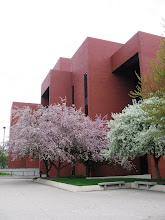Libraries Provide Valuable Benefits to Students, Faculty

The Libraries’ vision is to provide services that support student pursuits for academic success and faculty endeavors for knowledge creation and classroom instruction. Simply stated, we promise to be a destination for research, learning, and friends.
During the week of July 7, we asked students and faculty visiting the University Libraries what they valued most. Student responses were supportive of our destination concept by saying that the libraries are the place to go for them to get work done.
“I come here every day when I’m researching, so I’ll stay from two to four hours per day,” said Carissa Buchholz, a junior studying natural resources and environmental management. “I value the fourth floor because it is a quiet zone, and I can come here to focus and work.”
Faculty member Michael Brown, an associate professor in the Department of Criminal Justice, agrees. “I can come to the fourth floor and get work done with no distractions,” he said.
For some people, Bracken Library’s meeting and study rooms are an important attribute. There are 16 rooms of various sizes that can be reserved by the campus community. Haoyan Li, a student from China, said, “I like that my friends and class can use the meeting rooms and work together on assignments.”
Sherrod Bybee, a recent Ball State graduate and new member of the Channel 8 Weather Team at KLKN-TV in Lincoln, Nebraska, relates how video editing technology in the Libraries’ Multimedia Computing area allowed him to produce a polished résumé DVD containing his weather forecast segments. He feels that these examples of his work helped him to secure the job and launch his career.
Many people complimented the University Libraries for providing desktop and laptop printing and the availability of movies, CDs, and laptops for borrowing.
“I appreciate checking out DVD movies from the library,” said Cody Cramer, a graduate student in counseling. He also recognized the value of being able to easily print copies of articles, classroom PowerPoints, and other materials for study.
Interlibrary Loan Services are another highly valued service. Just ask Bridget Hahn, a graduate student in the Department of History. She refers to the ILS staff as heroes.
“I recently took a graduate writing seminar in which the bulk of the course is crafting a semester long research paper. I chose a topic that couldn't be easily researched on campus, but the folks in Interlibrary Loan helped me to obtain the materials I needed with a few books even arriving two days after I had requested them,” she said. “The prompt service, dedication to getting materials I needed and the ability to be reached for questions makes the people in Interlibrary Loan irreplaceable.”
The University Libraries’ personnel, collections, technology, study spaces and meeting rooms all contribute toward making the University Libraries valuable to the campus community. The Libraries are the destination for students and faculty to visit time and time again for research, learning, and friends







